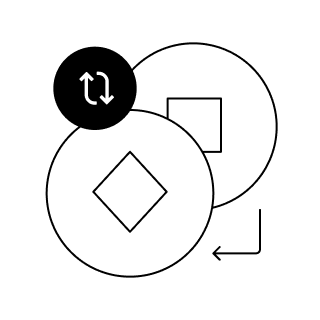How to buy Safe (SAFE) in 3 steps
Whether you’re new to crypto or an experienced trader, you can buy crypto using the OKX Exchange.
Step one
Get OKX
If you haven’t already, download the OKX app and sign up to get started.
Step two
Fund your account
Make a deposit using your preferred payment method.
Step three
Choose your crypto
Select the crypto you’d like to buy from the 3,000,000+ available on OKX.
What’s Safe (SAFE)? How can I buy it?
<h2>What is Safe?</h2>
<p>Safe (formerly Gnosis Safe) is a smart contract wallet and account abstraction platform designed to make digital asset custody, treasury management, and on-chain governance more secure and flexible. Unlike traditional externally owned accounts (EOAs) controlled by a single private key (e.g., a standard MetaMask wallet), Safe uses programmable smart contracts to enable multi-signature (multisig) control, granular permissions, recovery flows, and policy-based automation.</p>
<p>Safe underpins a significant portion of on-chain finance: DAOs, protocols, funds, and enterprises use Safe to secure treasuries, manage token allocations, execute multisig governance, and run operational workflows across multiple blockchains. The Safe protocol is live on Ethereum and many EVM-compatible networks, and it integrates with leading tools across DeFi, NFTs, and Web3 operations.</p>
<p>Key components:</p>
<ul>
<li>Safe Smart Account: A contract-based account that can require multiple signatures, enforce spending limits, schedule transactions, and interact with dApps like any wallet.</li>
<li>Safe Transaction Service and SDKs: Infrastructure and developer tooling that index safes, relay transactions, and simplify building with account abstraction.</li>
<li>Safe{Core}: A modular stack and standards suite that extends Safe accounts for advanced use cases (e.g., session keys, modules, and plugins).</li>
<li>SAFE token and SafeDAO: Governance for protocol upgrades, ecosystem grants, and the long-term evolution of the Safe stack.</li>
</ul>
<p>Notable adoption:</p>
<ul>
<li>Used by many top DAOs and teams (e.g., for multisig treasuries and grants).</li>
<li>Billions of dollars in assets are secured in Safe accounts across multiple networks.</li>
</ul>
<p>Sources: Safe documentation and app, Safe whitepapers and blog, Etherscan and analytics dashboards, industry coverage from reputable outlets.</p>
<h2>How does Safe work? The tech that powers it</h2>
<p>Safe’s core innovation is replacing the single private key model with programmable, on-chain logic executed by smart contracts. That logic governs how and when transactions can be authorized.</p>
<p>Architectural pillars:</p>
<ul>
<li>Smart Contract Accounts (SCAs): A Safe account is a proxy pointing to a shared singleton implementation. This design enables upgradability and consistent behavior across deployments. Owners (EOAs or other SCAs) are stored on-chain and can be added/removed with proper authorization.</li>
<li>Threshold Multisig: You can configure n owners with a threshold t (e.g., 3-of-5). A transaction proposed by one owner is valid only after it collects t signatures, then an executor (owner, relayer, or service) submits it on-chain to be executed by the Safe contract.</li>
<li>Modules and Guards: Extensibility layers. Modules can initiate transactions on behalf of the Safe (e.g., scheduled payouts, automation, spending policies), while Guards can inspect and approve/reject transactions before execution (e.g., allowlists/denylists, rate limits).</li>
<li>Fallback Handlers: Allow the Safe to handle arbitrary calls and data, enabling ERC-1271 signature validation (smart contract signatures) so dApps can verify “signatures” produced by an SCA rather than a private key. This preserves compatibility with existing dApp patterns.</li>
<li>Account Abstraction (AA) compatibility: Safe predates ERC-4337 but aligns with AA principles. Safe can be used as a smart account within ERC-4337 flows, supporting sponsors and paymasters (gas abstraction), batch transactions, and policy-based automation, enabling more user-friendly UX without exposing raw gas mechanics.</li>
<li>Signature Verification and Replay Protection: Off-chain signatures are collected per transaction hash, with nonce management in the Safe contract to prevent replay attacks. The Safe encodes the transaction’s to, value, data, operation type (call/delegatecall), gas params, and chainId in the signed payload.</li>
<li>Transaction Relaying: The Safe Transaction Service indexes pending transactions and signatures, while relayers can submit fully-signed transactions to the network. This improves coordination for distributed teams and DAOs and can abstract gas payment via sponsored flows.</li>
<li>Upgradability and Security: Safes are deployed via proxies (minimal proxies or EIP-1167-like patterns), pointing to audited, versioned implementations. The Safe team and independent auditors have conducted multiple audits; bug bounty programs and formal verification on critical paths add defense-in-depth.</li>
<li>Cross-Chain Deployments: The Safe contracts are deployed on Ethereum mainnet and many L2s/sidechains. Each chain’s Safe maintains its own state; teams often mirror ownership structures across chains and use operational playbooks or cross-chain tools to coordinate actions.</li>
</ul>
<p>Developer tooling:</p>
<ul>
<li>Safe Core SDKs: JavaScript/TypeScript libraries to create, sign, and execute Safe transactions, integrate Safe accounts in dApps, and interact with modules/guards.</li>
<li>Transaction Service API: Query pending transactions, signatures, owners, thresholds, and historical activity to power dashboards and automation.</li>
<li>Templates and Reference Modules: Rate limiters, spending policies, owner management flows, and role-based access patterns.</li>
</ul>
<p>Security considerations:</p>
<ul>
<li>Owner hygiene: Because owners are often EOAs or hardware wallets, good key management remains critical. Using hardware wallets, role separation, and redundant signers is recommended.</li>
<li>Module/guard audits: Extensibility is powerful but must be audited. Misconfigured modules or untrusted guards can introduce vulnerabilities.</li>
<li>Implementation upgrades: Upgradability should follow strict governance and timelocks; many teams pin Safe versions or require higher thresholds for upgrades.</li>
</ul>
<h2>What makes Safe unique?</h2>
<ul>
<li>Programmable custody at scale: Safe combines the robustness of multisig with a modular policy engine, enabling enterprise-grade controls (spending limits, role-based permissions) without sacrificing dApp compatibility.</li>
<li>Early and battle-tested AA: Safe has operated as a de facto smart account standard for years, securing billions in TVL. Its ERC-1271 support and alignment with ERC-4337 workflows give developers a mature path to account abstraction today.</li>
<li>Rich ecosystem and integrations: Safe is integrated across top DeFi apps, portfolio tools, governance systems, and DAO frameworks, reducing operational friction for teams and institutions.</li>
<li>Governance via SafeDAO: The SAFE token coordinates upgrades, grants, and ecosystem direction, aligning stakeholders around a neutral, open standard for smart accounts.</li>
</ul>
<h2>Safe price history and value: A comprehensive overview</h2>
<p>Note: Always verify token details (contract address, circulating supply) from reputable sources before trading.</p>
<ul>
<li>Token: SAFE (governance). Initially distributed to early users and ecosystem contributors via an airdrop and allocations governed by SafeDAO.</li>
<li>Utility: Primarily governance—proposing and voting on protocol changes, treasury usage, and ecosystem initiatives. The token does not confer custodial guarantees or yield by itself.</li>
<li>Market behavior: As a governance asset tied to critical infrastructure, SAFE’s value narrative often correlates with:
<ul>
<li>On-chain adoption of Safe accounts and modules.</li>
<li>Growth in TVL secured by Safe across chains.</li>
<li>Progress on account abstraction standards and integrations (e.g., ERC-4337 adoption).</li>
<li>SafeDAO governance milestones, grants, and roadmap delivery.</li>
</ul>
</li>
</ul>
<p>Because governance tokens can be volatile and influenced by broader market risk sentiment, SAFE may experience significant price swings. For historical charts, trading volumes, and exchange listings, consult reputable data aggregators and the project’s official channels.</p>
<p>Data sources to consult:</p>
<ul>
<li>CoinGecko, CoinMarketCap: Price history, market cap, circulating supply, exchange listings.</li>
<li>Etherscan and block explorers: Token contract, holders, transfers.</li>
<li>SafeDAO forum and Snapshot: Governance proposals and voting outcomes.</li>
<li>Safe’s official blog and docs: Roadmap, audits, and ecosystem updates.</li>
</ul>
<h2>Is now a good time to invest in Safe?</h2>
<p>This is not financial advice, but here are factors to consider when evaluating SAFE:</p>
<p>Bullish considerations:</p>
<ul>
<li>Category leadership: Safe is widely adopted for DAO and institutional custody—network effects can be defensible.</li>
<li>Account abstraction tailwinds: As wallets migrate to smart accounts, Safe’s infrastructure and standards may see increased demand.</li>
<li>Governance value: If SafeDAO steers meaningful treasury deployments, developer grants, and long-term protocol sustainability, the token’s governance rights may be valued by stakeholders.</li>
</ul>
<p>Risks:</p>
<ul>
<li>Governance token dynamics: SAFE’s value capture is indirect; it does not accrue fees unless governance explicitly introduces and directs value, which carries political and regulatory considerations.</li>
<li>Competitive landscape: Emerging ERC-4337-native smart accounts and wallet frameworks could fragment the market or commoditize features.</li>
<li>Security and upgrade risks: While heavily audited, critical infrastructure faces evolving threats. Misconfigurations in modules/guards can introduce vulnerabilities at the user level.</li>
<li>Market conditions: Macro crypto cycles heavily influence governance tokens independent of fundamentals.</li>
</ul>
<p>Practical diligence checklist:</p>
<ul>
<li>Verify the token contract and circulating supply on reputable explorers and aggregators.</li>
<li>Review SafeDAO proposals, voter participation, and treasury transparency.</li>
<li>Assess adoption metrics: number of Safes, assets secured (TVL), chain coverage, and ecosystem partnerships.</li>
<li>Examine development velocity: releases, audits, bug bounty activity, and roadmap execution.</li>
</ul>
<p>Conclusion:
Safe is a foundational piece of Ethereum’s smart account and multisig infrastructure, with strong real-world usage and a mature developer stack. For investors, the thesis typically hinges on governance exposure to a critical protocol in the account abstraction era. Balance that thesis against governance-token-specific risks, market volatility, and your own time horizon and risk tolerance.</p>
Discover the different ways to buy crypto in Australia
Here are a few step-by-step beginner’s guides to help you make your first purchase.
1
Create an OKX account
Download the OKX mobile app and sign up using your email address or phone number.
2
Get verified
Complete identity verification to secure your account. You’ll just have to provide your ID, a selfie, and some personal information.
3
Start a trade
Tap the Buy button on the homepage. Use the dropdown to select SAFE.
4
Enter an amount
Enter the amount of Safe you’d like to purchase in your local fiat currency.
5
Choose your payment method
Tap on Payment method and select Card. Tap on Preview to view your purchase details. Then, tap the Buy button to complete your purchase.
6
Confirm your order
If prompted, confirm your purchase on your bank’s associated mobile banking app.
7
All done
We’ll notify you once your purchase is complete. That’s it. You own crypto.
1
Get the OKX app or Wallet extension
Download the OKX mobile app on your mobile device or install the OKX Wallet extension.
2
Set up your wallet
Go to the menu and find Web3 Wallet. Follow the instructions to create or import a wallet. Make sure to back up your seed phrase.
3
Fund your wallet
Deposit your crypto into your OKX Wallet to cover your crypto purchase and network fees. You can make a direct deposit through the Exchange or receive the tokens from another wallet.
4
Find your next purchase
You can search for your desired crypto, paste its contract address directly into the search bar, or find it on the Tokens page.
Note:
Tokens with the same symbol can exist on multiple networks or may be forged. Always double-check the contract address and blockchain to avoid interacting with the wrong tokens.
Note:
Tokens with the same symbol can exist on multiple networks or may be forged. Always double-check the contract address and blockchain to avoid interacting with the wrong tokens.
5
Trade your crypto on OKX DEX
You can either select the token you want to buy and start trading right away, or find the token in your preferred trading mode on our Trade page.
Choose the token you’re paying with (e.g., USDT, ETH, or BNB), enter your desired trading amount, and adjust slippage if needed. Then, confirm and authorize the transaction in your OKX Wallet.
Limit order (optional):
If you’d prefer to set a specific price for your crypto, you can place a limit order in Swap mode.
Enter the limit price and trading amount, then place your order.
Choose the token you’re paying with (e.g., USDT, ETH, or BNB), enter your desired trading amount, and adjust slippage if needed. Then, confirm and authorize the transaction in your OKX Wallet.
Limit order (optional):
If you’d prefer to set a specific price for your crypto, you can place a limit order in Swap mode.
Enter the limit price and trading amount, then place your order.
6
Receive your crypto
Check your order status using the Explorer or on the History page. If your transaction is successful, you’ll receive your crypto in your wallet.
7
All done
You can now track and transfer your crypto, all in one place. That’s it. You own crypto.
Learn more about how to buy Safe (SAFE)

How to buy crypto?
Buying and trading cryptocurrency has become increasingly popular over the past decade. Its decentralized nature, accessibility, and anonymity are some of the reasons crypto has become so appealing. And now more and more investors are turning towards this form of trading.
22 Nov 2025|OKX|
Beginners

Complete tasks, earn rewards, kick-start your crypto journey.
Make informed decisions
Here are some things to look out for when deciding where to buy crypto.
Proof of Reserves
Ensure the exchange can cover your assets at all times.

High liquidity
High trading volumes enhance liquidity on an exchange.
Transparency
Historical market data should be available to you at all times.
Security
Ensure the exchange has taken steps to keep your account safe.

How to get Safe for free
Invite friends, earn rewards
See how you can get free Safe when you invite friends to trade with you.
Earn APY on your crypto
Earn interest down to every dollar and watch your Safe grow, for free. Put your crypto to work, 24/7.
See what you can do with your crypto
Now that you’ve mastered the art of buying crypto, check out its potential.
How to buy Safe (SAFE) FAQ
Depending on where you’re located, you can use bank transfer, credit/debit card, or Peer-to-Peer. Read our guide on how to use these different payment methods to buy Safe SAFE safely on a trusted exchange like OKX.
Choose the best exchange to buy Safe (SAFE) depending on your individual needs. Factors to consider when picking the best place to buy Safe (SAFE) include: security measures, platform transparency, fees, and efficient transaction processes. First-time beginners can consider trusted exchanges such as OKX.
Countries and regions differ on how digital assets transactions and holdings are taxed and how they view digital assets in general (money, property, commodity). In general, it is expected that you will pay capital gains tax when selling or swapping Safe. Refer here for a more detailed guide.
There are exchanges that offer users privacy and do not require verification to complete transactions. However, it is important to exercise caution as such exchanges might be more prone to fraud.
Use a trusted, centralized exchange such as OKX, which offers the ability to buy and sell Safe (SAFE), as well as fiat withdrawal options.
This depends on the method you use to convert Safe (SAFE) to cash. Withdrawals to a bank can take one to three working days to process, while withdrawals to a debit card can be almost instantaneous.
Disclaimer
This is provided for informational purposes only. It is not intended to provide (i) investment advice or an investment recommendation, (ii) an offer, solicitation, or inducement to buy, sell or hold digital assets, or (iii) financial, accounting, legal or tax advice. Digital assets, including stablecoins and NFTs, are subject to market volatility, involve a high degree of risk, and can lose value. You should carefully consider whether trading or holding digital assets is suitable for you in light of your financial condition and risk tolerance. Please consult your legal/tax/investment professional for questions about your specific circumstances. Not all products are offered in all regions. For more details, please refer to the OKX Terms of Use and Risk Warning. OKX Web3 Wallet and its ancillary services are subject to separate Terms of Service.














